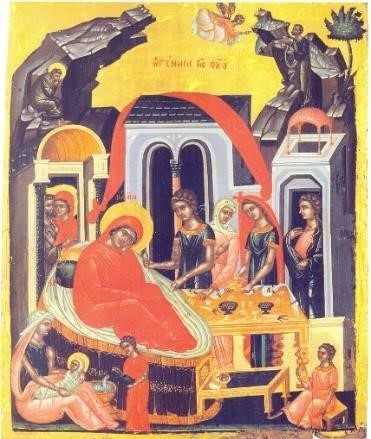What we know about the birth of the Theotokos comes to us from Sacred Tradition. The most significant source that speaks about the early life of the Mother of God is the Protoevangelium of James. The Icon of the Nativity of the Theotokos from St. Josaphat’s Cathedral essentially depicts what we read in this document. Joachim and Anna, the parents of Mary, were very well off. The red banner of fabric indicates that we are inside a home and we see that it is ornately decorated indicating their wealth. We also learn that they were childless and advanced in age. In the icon, Anna reclines looking in wonder at her daughter a miraculous gift from God in her old age. Two handmaids attend to her. The presence of the handmaids speaks to their wealth as well.
While the icon above shows only the scene as it is unfolding, many icons of the Nativity of the Theotokos depict scenes leading up to the birth of Mary as described in the Protoevangelium of James. The example to the right shows Joachim in the cave praying desperately to God for a child, and the angel visiting him to tell him of the upcoming conception. We also see Joachim and Anna embracing at the gateway to their house after each hearing the news from an angel.
There are similarities between the icon of the Nativity of the Theotokos and that of the Nativity of Christ. Anna is central and reclines gazing at her child, the result of a miracle, as does the Theotokos in icons of Christ’s Nativity whose birth giving was also miraculous. Below Anna, the infant Mary is bathed by midwives, just as the infant Jesus is in the icon of His birth.

It is significant that the Feast of the Nativity of the Theotokos comes at the beginning of the Liturgical Year. The birth of Mary signals the beginning of our salvation! The Saviour of the world will be born of her! From this moment of joy, which in itself is a miracle, begins the movement toward the miracle of the incarnation of Christ!
